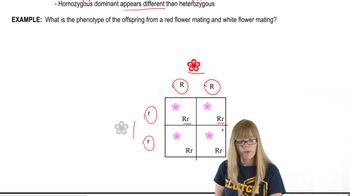- 1. Introduction to Genetics51m
- 2. Mendel's Laws of Inheritance3h 37m
- 3. Extensions to Mendelian Inheritance2h 41m
- 4. Genetic Mapping and Linkage2h 28m
- 5. Genetics of Bacteria and Viruses1h 21m
- 6. Chromosomal Variation1h 48m
- 7. DNA and Chromosome Structure56m
- 8. DNA Replication1h 10m
- 9. Mitosis and Meiosis1h 34m
- 10. Transcription1h 0m
- 11. Translation58m
- 12. Gene Regulation in Prokaryotes1h 19m
- 13. Gene Regulation in Eukaryotes44m
- 14. Genetic Control of Development44m
- 15. Genomes and Genomics1h 50m
- 16. Transposable Elements47m
- 17. Mutation, Repair, and Recombination1h 6m
- 18. Molecular Genetic Tools19m
- 19. Cancer Genetics29m
- 20. Quantitative Genetics1h 26m
- 21. Population Genetics50m
- 22. Evolutionary Genetics29m
Flower color in snapdragons results from the amount of the pigment anthocyanin in the petals. Red flowers are produced by plants that have full anthocyanin production, and ivory-colored flowers are produced by plants that lack the ability to produce anthocyanin. The allele An1 has full activity in anthocyanin production, and the allele An2 is a null allele. Dr. Ara B. Dopsis, a famous genetic researcher, crosses pure-breeding red snapdragons to pure-breeding ivory snapdragons and produces F₁ progeny plants that have pink flowers. He proposes that this outcome is the result of incomplete dominance, and he crosses the F₁ to test his hypothesis. What phenotypes does Dr. Dopsis predict will be found in the F₂, and in what proportions?
 Verified Solution
Verified SolutionVideo transcript

 4:37m
4:37mWatch next
Master Variations on Dominance with a bite sized video explanation from Kylia Goodner
Start learning

